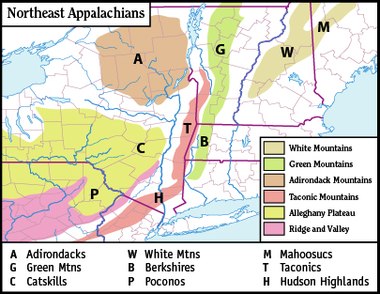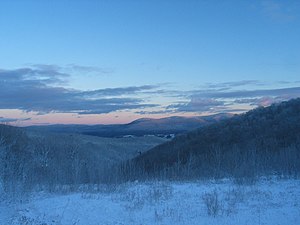Berkshires
This article needs additional citations for verification. (December 2008) |
The Berkshires (Template:Pron-en or /ˈbɜrkʃɪərz/), located in the western parts of Massachusetts and Connecticut[1], is both a specific highland geologic region and a broader associated cultural region. The region is also referred to as the Berkshire Hills, Berkshire Mountains, and, with regard to its physiography, Berkshire Plateau. Sir Francis Bernard, the Royal Governor, named the area "Berkshire," to honor his home county in England. Tourism is a principal industry, relying heavily on cultural art attractions and recreation.
Definition and context

Depending on the application, "The Berkshires" may have several different meanings.
Politically, Berkshire County, Massachusetts was a governing body formed in 1761; it includes the western extremity of the state, with its western boundary bordering New York and its eastern boundary roughly paralleling the watershed divide separating the Connecticut River watershed from the Housatonic River-Hoosic River watersheds. Geologically and physically, the Berkshires are the southern continuation of the Green Mountains of Vermont, distinct from them only by their average lower elevation and by virtue of what side of the border they fall on. As a physical geography, the Berkshires extend from the Housatonic River and Hoosic River valleys in western Massachusetts, to the Connecticut River valley in north central Massachusetts, and to the foot of the lower Westfield River valley in south central Massachusetts. In Connecticut, they extend from the upper Houstatonic River valley in the northwest part of the state, south along the western border of the state, east to the Farmington River valley in north central Connecticut, south to the Quinnipiac River valley in central Connecticut, then southwest to the Housatonic River valley in southwest Connecticut.
Culturally, however, the term "Berkshires" includes all of the highland region in western Massachusetts west of the Connecticut River and lower Westfield River, and all of northwest Connecticut from the Farmington River valley in the northern part of the state in a diagonal arc west to Winsted and Litchfield, then southwest to Lake Candlewood on the New York border and ending in Ridgefield, Connecticut. The cultural region also includes the Taconic Mountains bordering New York, which are geologically distinct from the Berkshires orogeny. Southwest Vermont and the Taconic region of New York are occasionally grouped with the Berkshires cultural region.
Counties
The Berkshires run primarily through three counties:
and
Geography
Geologically, the Berkshires are bordered on the west by the Taconic Mountains, the marble valleys of the Hoosic River and Housatonic River and, further south, by the Hudson Highlands; to the east, they are bordered by the Metacomet Ridge geology. They are on the average 1,000 ft (300 m) lower and less prominent than the Green Mountains of Vermont, and form a broad, dissected plateau punctuated by hills and peaks and cut by river valleys. The Berkshires topography gradually diminishes in profile and elevation from west to east and from north to south, except where rivers have cut deep gorges and sharp bluff faces into the Berkshire plateau.
The highest point in the Berkshires geology is Crum Hill, 2,841 feet (866 m) of Monroe, Massachusetts; however, Mount Greylock of the Taconic Mountains, 3,491 ft (1,064 m), the highest point in the state of Massachusetts, is considered the high point of the Berkshires cultural region. The average regional elevation of the Berkshires ranges from about 700 to 1,200 feet (213 to 365 meters). The Berkshires and related Green Mountains were formed over half a billion years ago when Africa collided with North America, pushing up the Appalachian Mountains and forming the bedrock of the Berkshires. Erosion over hundreds of millions of years wore these mountains down to the hills that we see today.[2]
The Housatonic River, Hoosic River, Westfield River, and Deerfield River watersheds drain the Berkshires region in Massachusetts; in Connecticut the main river drainages are the Farmington River, the Naugatuck River, the Shepaug River, and the Housatonic River.
The largest municipalities associated with the Berkshires cultural region include Pittsfield, North Adams, Adams, Great Barrington, and Williamstown, Massachusetts; and Winsted, Connecticut.
Ecology
As a framework for assessing environmental resources, the United States Environmental Protection Agency in Massachusetts (Griffith et al. 1994) has defined six different types of "ecoregions" within this area: Taconic Mountains, Western New England Marble Valleys, Lower Berkshire Hills, Berkshire Highlands, Vermont Piedmont, and Berkshire Transition. Each region is distinct from the others providing a unique habitat assemblage. Much of the Hoosic and Housatonic River Valleys have underlying bedrock limestone and marble which contribute to calcareous wetlands, unique to Massachusetts. The alkaline pH waters support a diversity of plants and animals intolerant of more acidic waters, some which are state-listed rare or endangered. Combined with the rich mesic forests ranging from the northern hardwood to the taiga or sub-alpine, makes for a valuable, biologically diverse ecosystem.
The classic study of the vegetation of the Berkshire Highlands was Egler's 1940 monograph,[3] covering the flora of an area stretching roughly from Pittsfield, MA in the west to Hatfield, MA in the east, and from Goshen, CT in the south, north to the Vermont border.
Today, efforts are being made on behalf of many organizations to preserve and manage this region for biological diversity and sustainable human development. Recreation directly related to this ecology is a popular area for trout fishing, and the area's relative pristineness contributes to the popularity of nature walks in the region. See also: Natural History of the Berkshires
Sightseeing

The Berkshires are a popular tourist attraction and vacation getaway, serving the same function in relation to Connecticut and Massachusetts that the Catskills do in New York and the Poconos for Pennsylvania. With numerous trails, including part of the Appalachian Trail, large tracts of wilderness, parks like Kent Falls, Berkshire Botanical Garden and Hebert Arboretum the Berkshires are very popular with nature lovers. The range includes Bash Bish Falls, the tallest waterfall in Massachusetts. The Berkshires are also home to dozens of summer camps, some of which date back to the turn of the 20th Century
Northwestern Connecticut features the covered bridges of Kent and West Cornwall, fly fishing, canoeing and spectacular fall foliage along the Housatonic River valley and the quiet woods and lichen-covered cracked granite hills of the Appalachian trail.
The Berkshire region is noted as a center for the visual and performing arts; its art museums include the Norman Rockwell Museum, the Clark Art Institute, the Massachusetts Museum of Contemporary Art (MassMoCA), and the Williams College Museum of Art (WCMA). At Williams College, the Chapin Library displays a wide selection of rare books and documents. Performing-arts institutions in the Berkshires include Tanglewood Music Center in Lenox, the summer home of the Boston Symphony Orchestra; Shakespeare & Company in Lenox; summer stock theatre festivals such as the Williamstown Theatre Festival in Williamstown and the Berkshire Theatre Festival in Stockbridge; and America's first and longest-running dance festival, Jacob's Pillow.
See also
- BerkShares
- Litchfield Hills
- Massachusetts geography
- Vegetation of New England
- Famous Berkshire Cottages: Naumkeag, Edith Wharton's The Mount, Ventfort Hall and Arundel Hall, used in the book The Penderwicks
The Berkshires are mentioned in the James Taylor song "Sweet Baby James":
- "Now the first of December was covered with snow.
- And so was the turnpike from Stockbridge to Boston.
- Lord, the Berkshires seemed dream-like on account of that frosting.
- With ten miles behind me and ten thousand more to go".
References
- ^ "Berkshire Hills". Geographic Names Information System. United States Geological Survey, United States Department of the Interior. Retrieved 2009-05-03.
- ^ Raymo, Chet and Maureen E. Written in Stone: A Geologic History of the Northeastern United States. Globe Pequot, Chester, Connecticut, 1989.
- ^ Egler, F. E. 1940. Berkshire plateau vegetation, Massachusetts. Ecological Monographs 10:147-192.
External links
- Browse the Berkshires
- Berkshire Visitor's Bureau
- Berkshire Visual Arts Guide to Galleries, Museums and Art Organizations
- Berkshire Chamber of Commerce
- Massachusetts State Parks in the Berkshires
- Explore the Berkshire Foothills of Western Massachusetts
This article needs attention from an expert in Massachusetts. Please add a reason or a talk parameter to this template to explain the issue with the article. (November 2008) |
